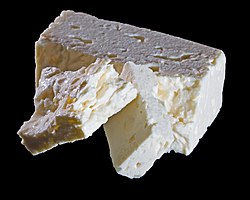
Back Feta Afrikaans فيتا (جبن) Arabic جبنه فيتا ARZ Feta AST Feta Azerbaijani Фета Byelorussian Фэта BE-X-OLD Фета Bulgarian Feta Catalan Feta Czech
| Feta | |
|---|---|
 | |
| Country of origin | Greece |
| Region | Mainland Greece and Lesbos Prefecture |
| Source of milk | Sheep (≥70%) and goat per PDO; similar cheeses may contain cow or buffalo milk |
| Pasteurized | Depends on variety |
| Texture | Depends on variety |
| Aging time | Min. 3 months |
| Certification | PDO, 2002 |
Feta (Greek: φέτα, féta) is a Greek brined white cheese made from sheep milk or from a mixture of sheep and goat milk. It is soft, with small or no holes, a compact touch, few cuts, and no skin. Crumbly with a slightly grainy texture, it is formed into large blocks and aged in brine. Its flavor is tangy and salty, ranging from mild to sharp. Feta is used as a table cheese, in salads such as Greek salad, and in pastries, notably the phyllo-based Greek dishes spanakopita "spinach pie" and tyropita "cheese pie". It is often served with olive oil or olives, and sprinkled with aromatic herbs such as oregano. It can also be served cooked (often grilled), as part of a sandwich, in omelettes, and many other dishes.
Since 2002, feta has been a protected designation of origin in the European Union (EU). EU legislation and similar legislation in 25 other countries[1] limits the name feta to cheeses produced in the traditional way in mainland Greece and Lesbos Prefecture,[2] which are made from sheep milk, or from a mixture of sheep milk and up to 30% of goat milk from the same area.[3]
Similar white brined cheeses are made traditionally in the Balkans, around the Black Sea, in West Asia, and more recently elsewhere. Outside the EU, the name feta is often used generically for these cheeses.[4]
- ^ Cite error: The named reference
Originwas invoked but never defined (see the help page). - ^ Cite error: The named reference
GIViewwas invoked but never defined (see the help page). - ^ Gooch, Ellen (Spring–Summer 2006). "Truth, Lies, and Feta: The Cheese that Launched a (Trade) War". Epikouria: Fine Foods and Drinks of Greece. Triaina Publishing. Archived from the original on 5 July 2009.
- ^ Pappas, Gregory (2015). "Feta Cheese at the Heart of Growing US-EU Trade Tensions". The Pappas Post. Elite CafeMedia Lifestyle.